Your body produces tears naturally to keep your eyes lubricated, since it’s one of the few parts of your body mucus membranes open to the outside world.
But sometimes natural tears aren’t enough. This is where eye drops can help.
To augment natural tears and help prevent dryness, itching, and redness, eye drops are the best solution. There’s a huge variety to choose from, but fortunately, we’ve ranked the ten best eye drops on the market in descending order.
1. GenTeal Tears Moderate
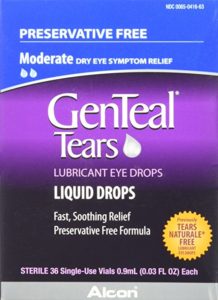
Click here for the lowest price on Amazon
GenTeal Tears is a single-use vial eye drop that is an excellent choice for people who have sensitive eyes and who don’t respond to more basic lubricating and hydrating solutions. GenTeal Tears also comes in a “mild” and a “severe” formulation, but those come in larger bottles and include preservatives.
GenTeal Tears uses the less-common lubricants dextran 70 and hypromellose 2910 eye drops, so if your dry eyes haven’t responded to more simple formulations like glycerine or mineral oil, GenTeal Tears is worth a try. GenTeal Tears also has very large individual vials, at 0.9 mL each.
This is three times as big as some of its competitors, so people who need larger amounts of eye drop solution per application should also look into GenTeal Tears.
2. Ocusoft Retaine MGD
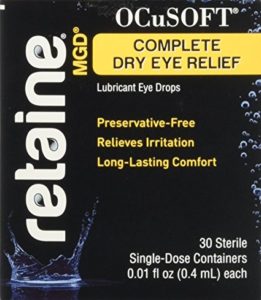
Click here for the lowest price on Amazon
Ocusoft Retaine MGD is a specially formulated eye drop that’s preservative-free and comes in single use vials. It is designed specifically for excessive eye dryness and uses a proprietary fluid technology to assure that the solution is evenly distributed in your eye.
The liquid looks cloudy at first; it’s not until you’ve put it in your eye and blinked a few times that the particles are evenly distributed, forming a thin film that coats your eye for long-lasting relief.
These are a favorite among people whose eyes are sensitive to the preservatives in other eye drops and for people with very dry eyes.
3.TheraTears Dry Eye Therapy
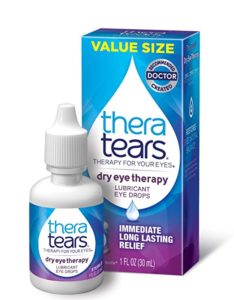
Click here for the lowest price on Amazon
TheraTears is a good option if your eyes are somewhat sensitive and haven’t responded to the usual lubricants. It uses sodium carboxymethylcellulose, which is a lubricant not found in too many other eye drops.
Additionally, it uses preservatives that are not likely to aggravate your eyes even when used frequently. These eye drops are especially beloved by people who have extremely dry eyes and who’ve been failed by other brands, but it’s good enough to warrant trying in its own right.
4. Blink Tears
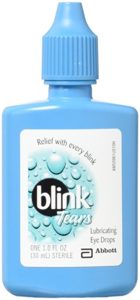
Click here for the lowest price on Amazon
Blink Tears is an eye drop that shines particularly well when it comes to lubricating your eyes. If your eyes feel dry and scratchy at the end of the day on occasion, Blink Tears is a good product to try.
The one ounce bottle is conveniently sized for travel, though the fact that the bottle is reusable necessitates the inclusion of a preservative. The sodium chlorite used to preserve Blink Tears is not likely to be a major irritant, but regular eye drop users with sensitive eyes may want to opt for a single-use product that comes in disposable vials.
5. Clear Eyes Pure Relief Multi-Symptom
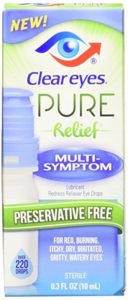
Click here for the lowest price on Amazon
For an all-purpose eye drop, this is the number one contender. Clear Eyes Pure Relief Multi-Symptom offers a well-balanced mix of ingredients that lubricate, hydrate, and reduce redness, plus it takes the wise step of including only preservatives that are not likely to aggravate the eye.
Users love the solution, but one sticking point is the bottle–it’s not designed very well and it’s difficult to squeeze drops out. Aside from that, it’s a great all-around eye drop solution.
6. Systane Balance

Click here for the lowest price on Amazon
Systane Balance is focused on improving eye lubrication and preventing dryness by restoring the body’s natural lipid layer in teardrops.
This way, water isn’t just lost to evaporation again. Systane Balance is renowned for its ability to keep eyes hydrated and happy with only one or two applications per day.
Many people find Systane Balance to be ideal for keeping their eyes from drying out after they remove their contact lenses at night.
7. Oasis Tears Plus
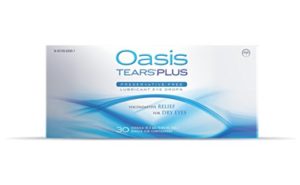
Click here for the lowest price on Amazon
Oasis Tears Plus is a glycerin based eye drop that comes in single use vials, which means it’s preservative-free. It’s a good choice for sensitive eyes that just need some basic, straightforward lubrication and hydration.
Some people find that the 0.3 mL vial size is not big enough for a full application, so if you notice that you tend to use more eye drop solution than average every time you apply eye drops, this might not be the product for you. There are other options out there that come in larger vial sizes
8. Bausch + Lomb Soothe XP

Click here for the lowest price on Amazon
Bausch + Lomb use plain old mineral oil in this eye drop formulation to lubricate and rehydrate the eyes, but by choosing to do so, they are able to get longer-lasting relief and a far lower chance of a negative reaction from sensitive eyes.
Nearly 5% of the liquid in the solution is mineral oil, so these eye drops have quite the ability to protect the eye’s moisture level by restoring a lipid barrier.
On the flip side, a more simplistic formula like this means that the hydrating and lubricating power of these eye drops won’t last all day like some competitors with more advanced formulations.
9. Zaditor Antihistamine Eye Drops
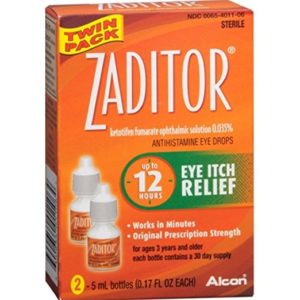
Click here for the lowest price on Amazon
Zaditor Antihistamine Eye Drops are specifically designed for eye itching and redness that’s the result of allergies. It includes ketotifen, an antihistamine that works to reduce your body’s inflammatory reaction against allergens in your eye, which is the cause of allergy-related eye itching.
The formulation does include benzalkonium chloride as a preservative, so it may cause irritation in sensitive eyes if used continuously for a long period of time.
Notably, this eye drop does not offer any kind of lubricating or hydrating ingredients, so if you have itchy and dry eyes, you may want to try something else first.
10. Visine Maximum Strength Redness Relief
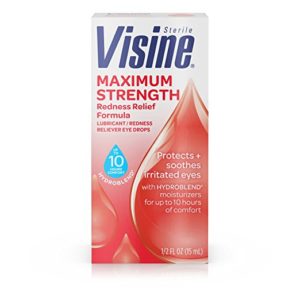
Click here for the lowest price on Amazon
Visine Maximum Strength is a heavy-hitting eye drop that is intended to take out redness and irritation as quickly as possible.
To this end, it has three active lubricants and an anti-redness and irritation agent included. As a reusable vial, it needs a preservative to keep it sterile, and Visine chose benzalkonium chloride to do the job.
It loses some marks for this, as many people find that this preservative actually causes eye irritation. So, while popular, the formulation might be self-defeating for some people.
Eye drop benefits and side effects
Eye drops are used primarily to combat dryness, scratchiness, redness, or itching in the eye. These can be from a variety of causes, so as a result, there are a number of different kinds of eye drops that have evolved to treat the different causes of eye irritation.
Choosing the right eye drop is, in part, a matter of figuring out what the cause of your issues are and choosing an eye drop that will address the root problem.
Benefits
Eye drops are about more than just hydrating your eyes. The reason your eyes lose moisture and feel dry is because the lipid layer in your eye breaks down and allows water to evaporate from your eyes. When used to treat dry or irritated eyes, restoring this lipid layer is a major part of the solution.
A research paper published in 2005 in the journal Optometry and Vision Science describes how an eye drop can restore this lipid layer (1).
The authors describe an experiment in which two different eye drops were used on human eyes, which were then measured using a custom-designed tool to use light beams to measure the thickness of the lipid layer.
The experiment found that both eye drops, which used two different kinds of lubricants, increased the thickness of this lipid layer, though by different amounts. This indicates that some lubricating eye drop compounds may work better than others and moreover, this may explain why different people have different reactions to the same eye drop–their body may not be increasing its lipid layer thickness by the same amount as someone else’s. If a certain eye drop does not seem to reduce eye dryness, try one with a different active ingredient.
These active ingredients can range from simple compounds like mineral oil and glycerin to less common ones like dextran 70. Check the label before you try a new eye drop.
It’s a different story when it comes to fighting redness and itching that results from allergies. In this case, an antihistamine ingredient is needed.
A scientific experiment described in an article in the British Journal of Ophthalmology in 2003 demonstrated the efficacy of antihistamines in reducing the symptoms of redness and itchiness that result from allergic reactions (2).
In it, over 500 subjects in Australia were given either a placebo eye drop or one of two experimental antihistamines to treat their seasonal allergy symptoms related to their eyes. After four weeks, the researchers evaluated the condition of the subjects.
They found that the ketotifen eye drops (the antihistamine now used in many anti-allergy eye drops) was the most effective treatment, and demonstrated its efficacy by showing that it blocked the reaction of inflammatory immune cells in the eye. The subjects also reported less accumulation of grit in their eyes and vastly lower levels of redness and itching.
Regardless of whether you are using an eye drop with lubricants for dry eye, antihistamines for allergies, or both, one major concern for all eye drop users is the need to prevent contamination of the eye drop solution. Since the eye is a direct portal to the interior of your body, it’s very susceptible to infections if bacteria contaminate your eye drop solution.
There are two ways to prevent this. The first is by supplying eye drops in sealed, sterilized, single-use containers that are used once, then discarded. This is somewhat more expensive, but allows you to use eye drops that are as pure as possible.
The other option is to use a preservative, and this is what most manufacturers elect to do. There are a wide range of preservatives available, but several, like sodium chlorite, appear to be effective at preventing bacterial growth but not aggravating the eye. Some older preservatives aren’t as successful and have the tendency to cause side effects.
Side Effects
Finding the right eye drop can be even more difficult than finding the right deodorant or antiperspirant, especially if you have sensitive eyes.
The eyeball is an area of the body that is highly sensitive to outside contaminants, so many people react poorly to a great number of eye drops. One common ingredient to watch out for is benzalkonium chloride, which is a very effective preservative but appears to have both toxic and allergenic properties.
According to a 2010 article by researchers in Paris, France in the scientific journal Progress in Retinal and Eye Research, benzalkonium chloride is moderately allergenic in the short term, and toxic in the long term (3).
This means that it has the tendency to promote a reaction from the immune system to attack the chemical, and it also has a tendency to damage eye tissue over time.
The authors of the scientific paper recommend only using eye drops containing benzalkonium chloride for a short period of time, if at all.
Contamination is another potential source of side effects. This should not be a problem if you follow the directions on your eye drops–namely, only using single-use vials one time, and throwing away even a preservative-based eye drop if it is past its expiration date.
This can be a source of trouble for occasional users who may use eye drops only a couple times a week. They should opt for single-use vials to reduce the temptation to push their reusable vials past their appropriate shelf life.
Recap
Eye drops are a great solution if you’ve got dried out, irritated, or red and itchy eyes. Choosing the right eye drop is a matter of figuring out whether you need lubrication and hydration or an antihistamine to solve your problems.
Then you need to determine whether single use vials or reusable vials with preservatives are a better investment. For occasional users, or people with highly sensitive eyes, single use vials are best.
For regular eye drop users, a preservative based vial is better, but you should strive to avoid one with benzalkonium chloride as a preservative if possible, especially if you’ll be using your eye drops on a regular basis or for a prolonged period of time.
https://bodynutritionorg.wordpress.com/2018/02/11/ranking-the-best-eye-drops-of-2018/
No comments:
Post a Comment